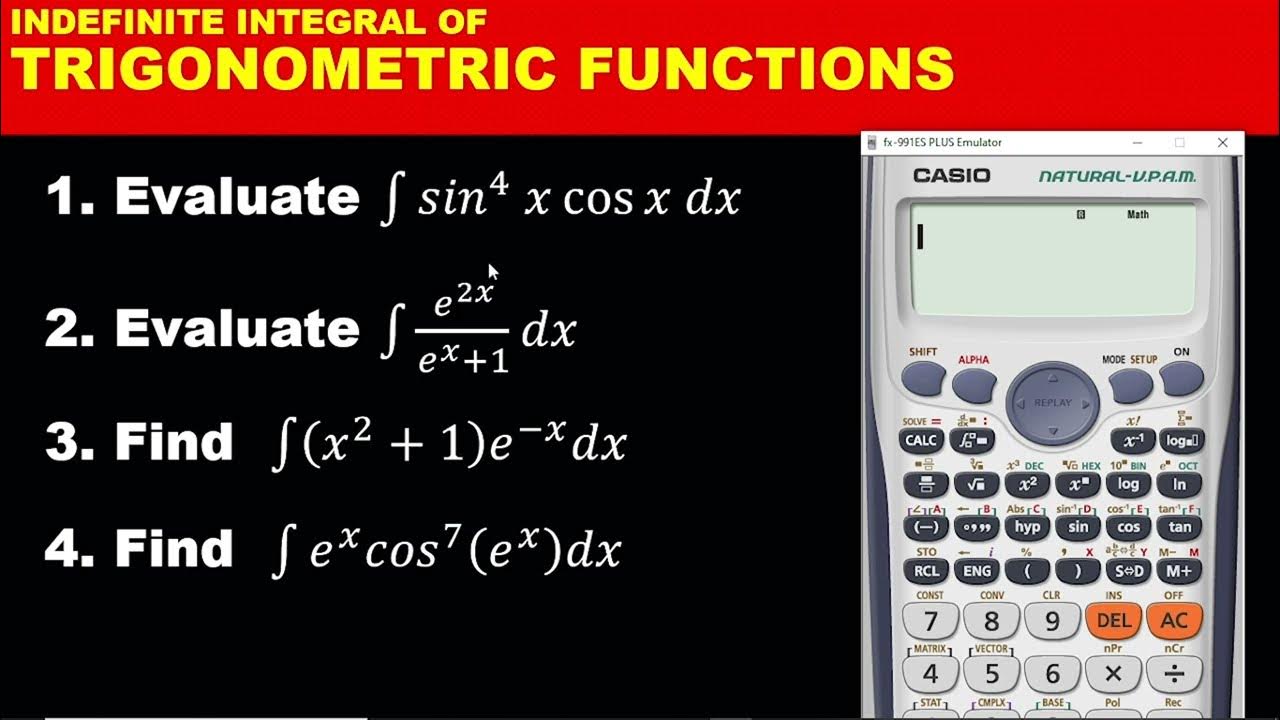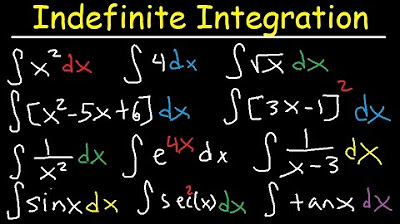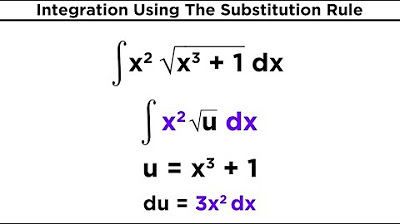Integration Formulas For Trig Substitution
TLDRThe video script provides a detailed walkthrough on using special integration formulas to find the indefinite integral of trig substitution problems. It illustrates the process with three examples, emphasizing the importance of correctly identifying variables and incorporating dx into the integral expression. The script methodically demonstrates how to apply the formulas, replace variables, and simplify the expressions to arrive at the final answers, offering a clear guide for those learning to integrate complex functions.
Takeaways
- 📚 The video discusses the use of special integration formulas to find the indefinite integral of trig substitution problems.
- 🔍 The first example problem is the integral of the square root of 25 minus 4x squared dx, which requires identifying the correct formula for integration.
- 🎯 The antiderivative formula for the square root of a squared minus u squared is crucial for solving the given example problems.
- 📈 To solve the problems, one must determine the values of 'a' and 'u' by correlating them to the given expressions.
- 🌟 It's important to convert the integral expression from 'x' to 'u' and to replace 'dx' with 'du/2' to correctly apply the formula.
- 📊 The second problem involves finding the indefinite integral of 16 minus 4x squared dx, following a similar process as the first example.
- 🔢 For the third problem, the integral of the square root of 16x squared plus nine dx is tackled using a different formula for a different form of expression.
- 👉 The process of changing variables from 'x' to 'u' and solving for 'dx' in terms of 'du' is emphasized as a key step in these integrations.
- 💡 The video provides a clear warning about the common mistake of not properly incorporating 'du' into the integral expression, which can lead to incorrect answers.
- 📝 The final answers for the examples are provided in a simplified form, demonstrating the successful application of the integration formulas.
- 🎓 The video serves as an educational resource for those looking to understand and apply special integration formulas to solve trig substitution problems.
Q & A
What is the main topic of the video?
-The main topic of the video is how to use special integration formulas to find the indefinite integral of trig substitution problems.
What is the integral of the square root of 25 minus 4x squared dx?
-The integral of the square root of 25 minus 4x squared dx is (25/4) * arc sin(2x/5) + (x/2) * sqrt(25 - 4x^2) + C.
How do you determine the values of 'a' and 'u' in the formula for the integral of the square root of a squared minus u squared?
-In the given example, 'a' corresponds to the square root of 25, which is 5, and 'u' corresponds to the square root of 4x squared, which is 2x.
Why is it important to solve for 'dx' in terms of 'du' when using the integration formula?
-It is important to solve for 'dx' in terms of 'du' to ensure that the integral expression is correctly transformed, which is necessary for the accurate application of the formula and to avoid getting the wrong answer.
What is the significance of replacing dx with du/2 in the integral expression?
-Replacing dx with du/2 is crucial because it incorporates the relationship between dx and du, which is necessary for the correct application of the integration formula and obtaining the correct result.
What is the integral of 16 minus 4x squared dx using the same process?
-The integral of 16 minus 4x squared dx is 4 * arc sin(x/2) + (x/2) * sqrt(4 - x^2) + C.
How do you identify the values of 'a' and 'u' for the problem involving the integral of 16x squared plus nine dx?
-In this case, 'a' squared is nine, which means 'a' is 3, and 'u' squared is 16x squared, so 'u' is 4x.
What is the final answer for the indefinite integral of the square root of 16x squared plus nine dx?
-The final answer is (1/2) * x * sqrt(16x^2 + 9) + (9/8) * ln(4x + sqrt(16x^2 + 9)) + C.
Why is it necessary to change the variable x to u in the integral expression?
-Changing the variable x to u simplifies the expression and allows for the application of the integration formula by aligning the terms with the formula's structure.
How does the process of substituting values and transforming the integral expression help in solving the problem?
-The process of substitution and transformation ensures that the integral expression matches the formula's structure, which facilitates the correct application of the formula and leads to the accurate solution of the integral.
What is the general approach to solving these types of trig substitution integration problems?
-The general approach involves identifying the appropriate formula, determining the values of 'a' and 'u', transforming the integral expression by changing variables when necessary, and carefully substituting values into the formula to obtain the final answer.
Outlines
📚 Introduction to Trigonometric Substitution and Special Integration Formulas
This paragraph introduces the concept of using special integration formulas to find the indefinite integral of trigonometric substitution problems. The video begins with an example problem, the integral of the square root of 25 minus 4x squared dx. It emphasizes the importance of identifying the correct formula to use, which in this case is the antideriviative of the square root of a squared minus u squared, du. The process involves determining the values of a and u, which are found by comparing the given expression to the formula. The paragraph then walks through the steps of substituting the values into the formula, including the crucial step of converting dx to du over 2, and finally arriving at the correct indefinite integral.
📈 Application of Integration Formulas to Specific Examples
The second paragraph continues the discussion on applying integration formulas to specific examples. It presents another problem, the indefinite integral of 16 minus 4x squared dx, and guides the viewer through the process of identifying a and u, and substituting these values into the formula. The paragraph explains the steps of replacing the given expressions with the corresponding variables, and the importance of solving for dx in terms of du. The summary culminates in the final answer, which is presented in a simplified form.
🔢 Solving More Complex Trigonometric Substitution Problems
The final paragraph tackles more complex problems involving the square root of a sum of squared terms. The example given is the indefinite integral of the square root of 16x squared plus nine dx. The paragraph explains the selection of the appropriate formula and the process of identifying the values of a and u. It details the steps of converting the variable x to u, solving for dx in terms of du, and substituting these into the formula. The paragraph concludes with the final answer, showcasing the application of the integration technique to a more complicated problem.
Mindmap
Keywords
💡Trig Substitution
💡Indefinite Integral
💡Special Integration Formulas
💡Antiderivivative
💡Square Root
💡Arcsine Function
💡U-Substitution
💡Natural Logarithm
💡Integration by Parts
💡Constant
💡Variable
Highlights
The video discusses the use of special integration formulas to find the indefinite integral of trig substitution problems.
An example problem is provided to illustrate the process: finding the integral of the square root of 25 minus 4x squared dx.
The antiderivative of the square root of a squared minus u squared is given by (1/2)a^2 * arcsin(u/a) + u * sqrt(a^2 - u^2) + C.
The values of 'a' and 'u' must be determined to apply the formula correctly to the example problem.
In the example, 'a' is found to be 5 and 'u' is 2x, after identifying 25 as a^2 and 4x^2 as u^2.
The process emphasizes the importance of incorporating the differential dx correctly into the formula, which is 2x in this case.
The integral expression should be converted from x to u before applying the formula to avoid mistakes.
The final answer for the first example is (25/4) * arcsin(2x/5) + (x/2) * sqrt(25 - 4x^2) + C.
The video proceeds to solve another problem, finding the indefinite integral of 16 - 4x^2 dx using the same method.
For the second problem, 'a' is determined to be 4, and the integral formula is applied accordingly.
The final answer for the second problem is 4 * arcsin(x/2) + (x/2) * sqrt(4 - x^2) + C.
A third problem is tackled, finding the indefinite integral of the square root of 16x^2 + 9 dx.
The formula for the integral of the square root of u^2 + a^2 is used, which includes natural logarithm and other components.
The values of 'a' and 'u' for the third problem are identified as 3 and 4x, respectively.
The final answer for the third problem is (1/2) * x * sqrt(16x^2 + 9) + (9/8) * ln(4x + sqrt(16x^2 + 9)) + C.
The video concludes by summarizing how special integration formulas can be used to integrate trig substitution problems effectively.
Transcripts
Browse More Related Video

Integration By Tables

INTEGRATION PART 2: CALCULATOR TECHNIQUES ON INDEFINITE INTEGRATION OF TRIGONOMETRIC FUNCTIONS

Indefinite Integral - Basic Integration Rules, Problems, Formulas, Trig Functions, Calculus

Integration Using The Substitution Rule

Definite Integral With U-Substitution

Power Rule for Integrals
5.0 / 5 (0 votes)
Thanks for rating: